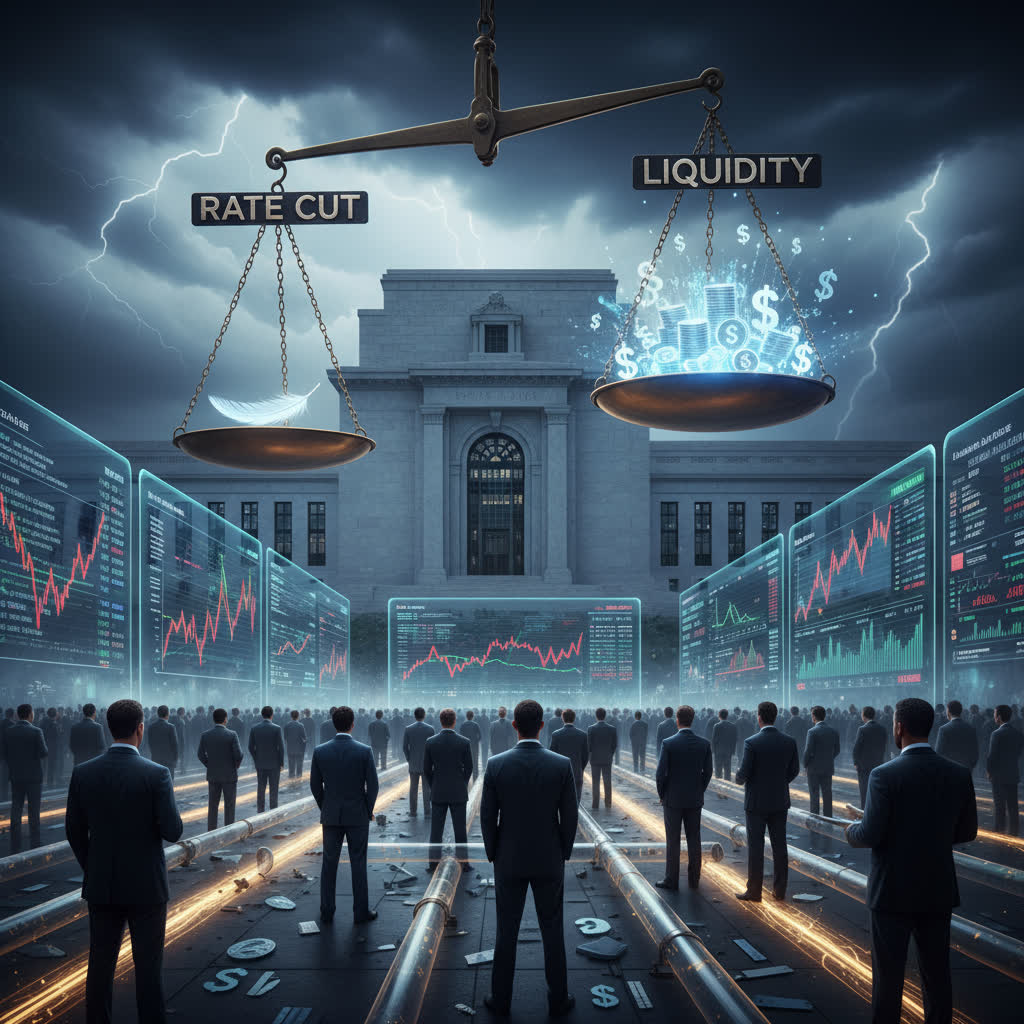Global financial markets are entering a delicate “transition phase” — one where every trader, investor, and policymaker has their eyes fixed on the U.S. Federal Reserve. As of now, markets are pricing in a 100% probability that the Fed will cut interest rates at its upcoming meeting.
But the real question isn’t whether the Fed will cut.
It’s what message lies behind that decision — and what comes next.
1. When Expectation Replaces Uncertainty
When the market fully prices in an event — at 100% certainty — all elements of surprise are gone.
There’s no more “if” — only “when.”
At that point, the real shock no longer comes from the decision itself, but from how the Fed frames it and what follows afterward.
Investors aren’t focused on “how much” the Fed will cut, but on the policy signal embedded in that number — the tone, the guidance, and the reaction function that will shape the next phase of market behavior.
2. Cutting Rates ≠ Injecting Liquidity
One of the biggest misconceptions in markets is the assumption that rate cuts automatically mean more liquidity.
They don’t.
A rate cut merely changes the cost of capital, not the availability of capital.
True financial liquidity comes from the underlying plumbing of the monetary system, particularly through:
-
Bank Reserves: The amount of money commercial banks hold at the Fed.
-
Repo Market (Repurchase Agreements): Short-term funding flows between financial institutions.
-
Credit Spreads: A measure of credit risk and investor confidence in the bond market.
These three elements form the lifeblood of liquidity.
It’s entirely possible for rates to fall while liquidity is actually being drained — especially when the U.S. Treasury (TGA) rebuilds its cash balance or the Fed absorbs liquidity via the Overnight Reverse Repo (ON RRP) facility.
3. From “Policy Drives Liquidity” to “Liquidity Drives Policy”
In past economic cycles, the Fed was the driver — monetary policy led, and liquidity followed.
Now, the dynamic has flipped.
The market — not the Fed — is calling the shots.
Capital flows, liquidity conditions, and credit tightening are dictating how the Fed reacts.
When liquidity contracts, credit spreads widen, and long-term yields stay elevated, the Fed’s hands are tied. It can only chase the market to prevent broader instability — not lead it.
4. A Trader’s Playbook: Don’t Chase the News, Follow the Flow
For traders, this isn’t a time to bet on headlines — it’s a time to read the money flows.
Here’s how:
-
Price in early. When markets have already priced in a 100% probability, most of the easy profits are gone before the event happens.
-
Avoid the initial reaction. The first rally (or selloff) after a rate announcement is often the wrong direction.
-
Track liquidity indicators closely:
-
ON RRP: If funds are flowing out, liquidity is returning to the market.
-
TGA: If Treasury cash balances fall, liquidity is being released.
-
Bank Reserves: If they rise, that’s a clear signal of money re-entering the system.
-
Ultimately, flows matter more than Fed words.
5. The Message Behind the Cut
The size of the cut itself tells a story:
-
25 basis points (bps) → “We’re cautious. We want to see more data.”
-
50 basis points (bps) → “We’re behind the curve and need to act fast.”
The difference between 25 and 50 bps isn’t about direction — it’s about tone.
One signals measured confidence, the other urgent concern.
The cut, in essence, becomes a language of psychology — a reflection of how worried the Fed truly is about systemic risks.
6. The Bottom Line: Policy Creates the Narrative, Liquidity Creates the Trend
In today’s market, monetary policy is merely the visible surface of a much deeper structure.
What truly drives asset prices — the real current beneath the surface — is liquidity flow: whether money is being injected into or drained from the system.
As the world waits for next week’s Fed decision, the real question isn’t about a rate cut.
👉 It’s about what happens after:
Will the Fed inject enough liquidity to reignite market momentum — or will it merely offer temporary relief while deeper tightening continues underneath?
Ready to start your cryptocurrency journey?
If you’re interested in exploring the world of crypto trading, here are some trusted platforms where you can create an account:
- Binance – The world’s largest cryptocurrency exchange by volume.
- Bybit – A top choice for derivatives trading with an intuitive interface.
- OKX – A comprehensive platform featuring spot, futures, DeFi, and a powerful Web3 wallet.
- KuCoin – Known for its vast selection of altcoins and user-friendly mobile app.
These platforms offer innovative features and a secure environment for trading and learning about cryptocurrencies. Join today and start exploring the opportunities in this exciting space!

Join our crypto community for news, discussions, and market updates: CryptoBCC on Telegram.

Disclaimer: Always do your own research (DYOR) and ensure you understand the risks before making any financial decisions.




